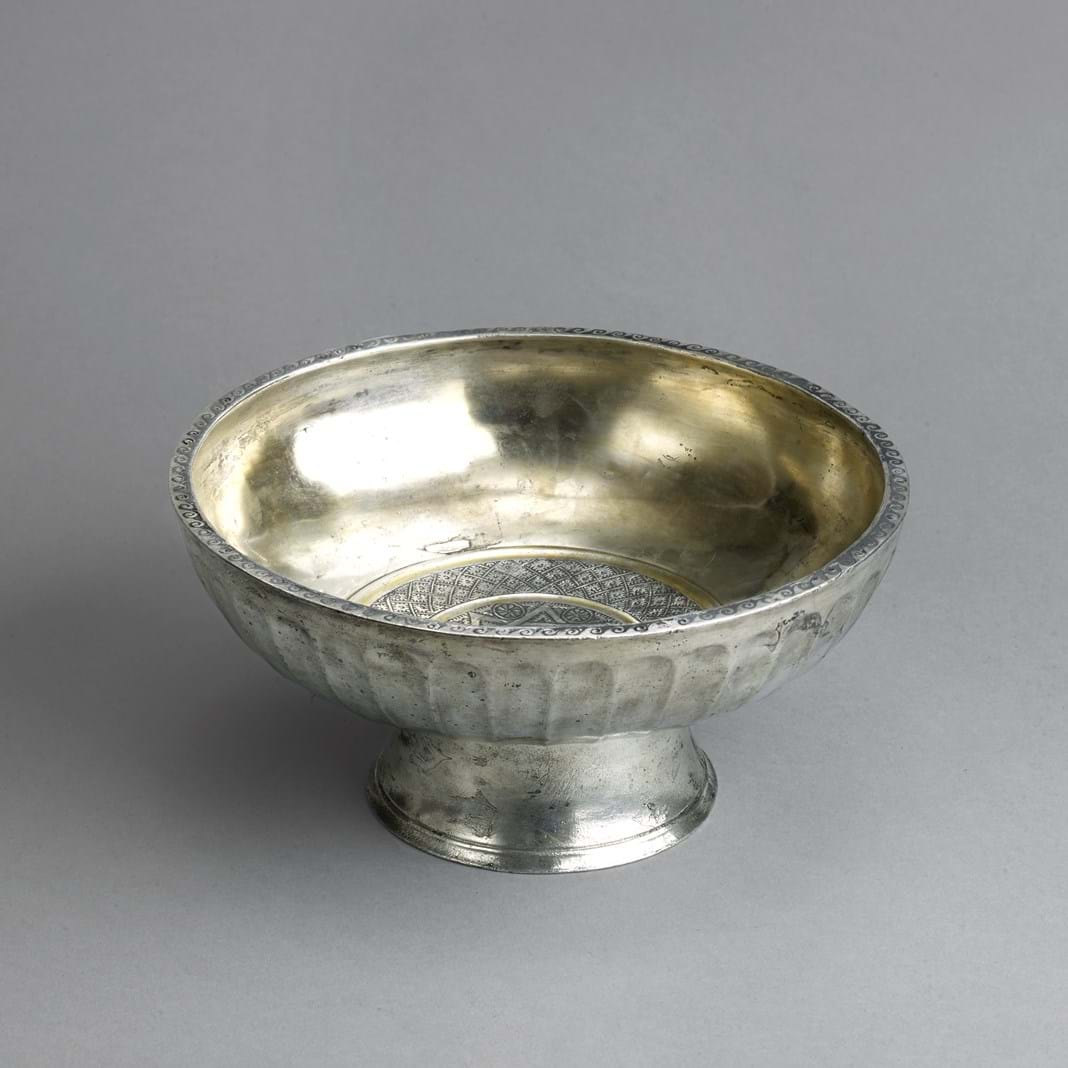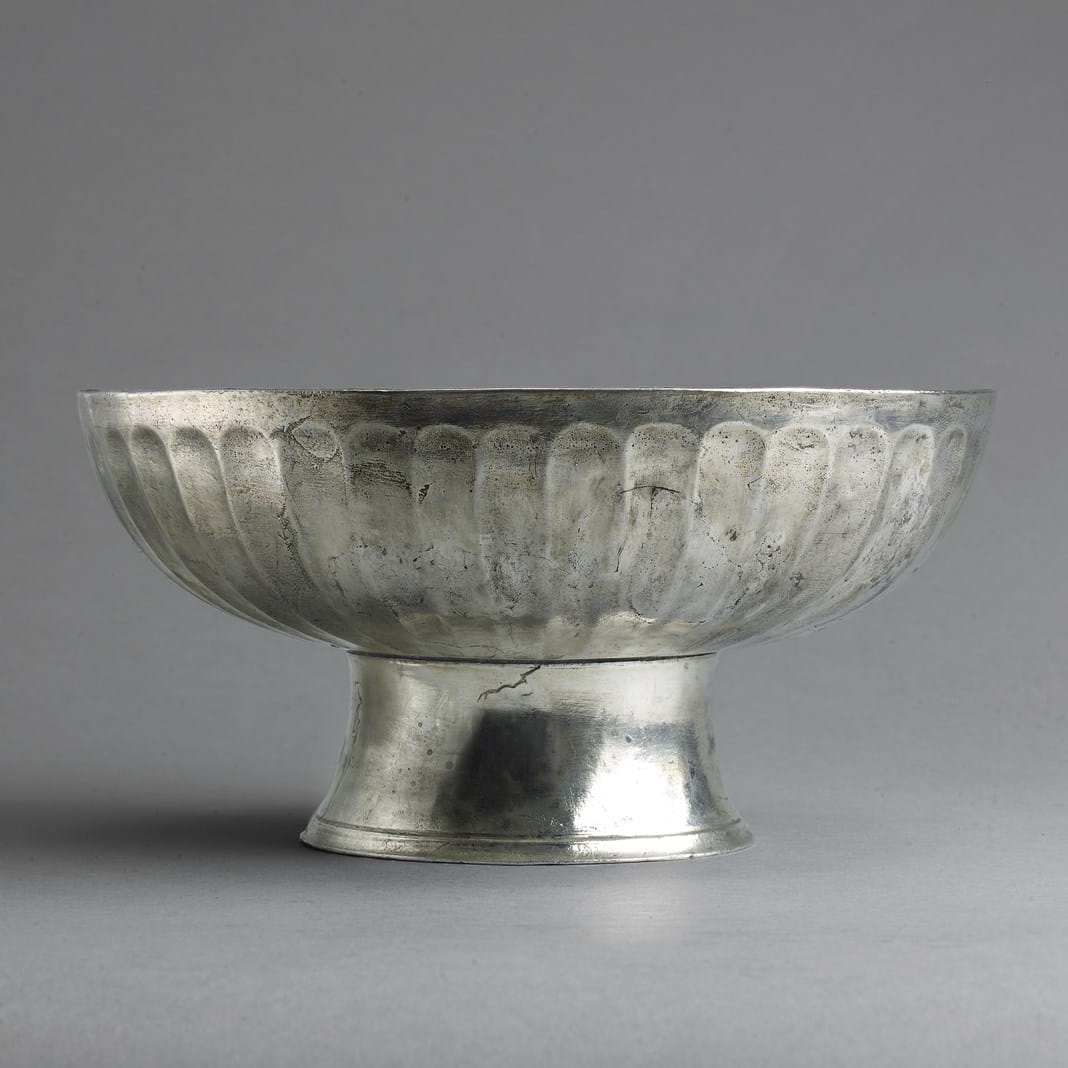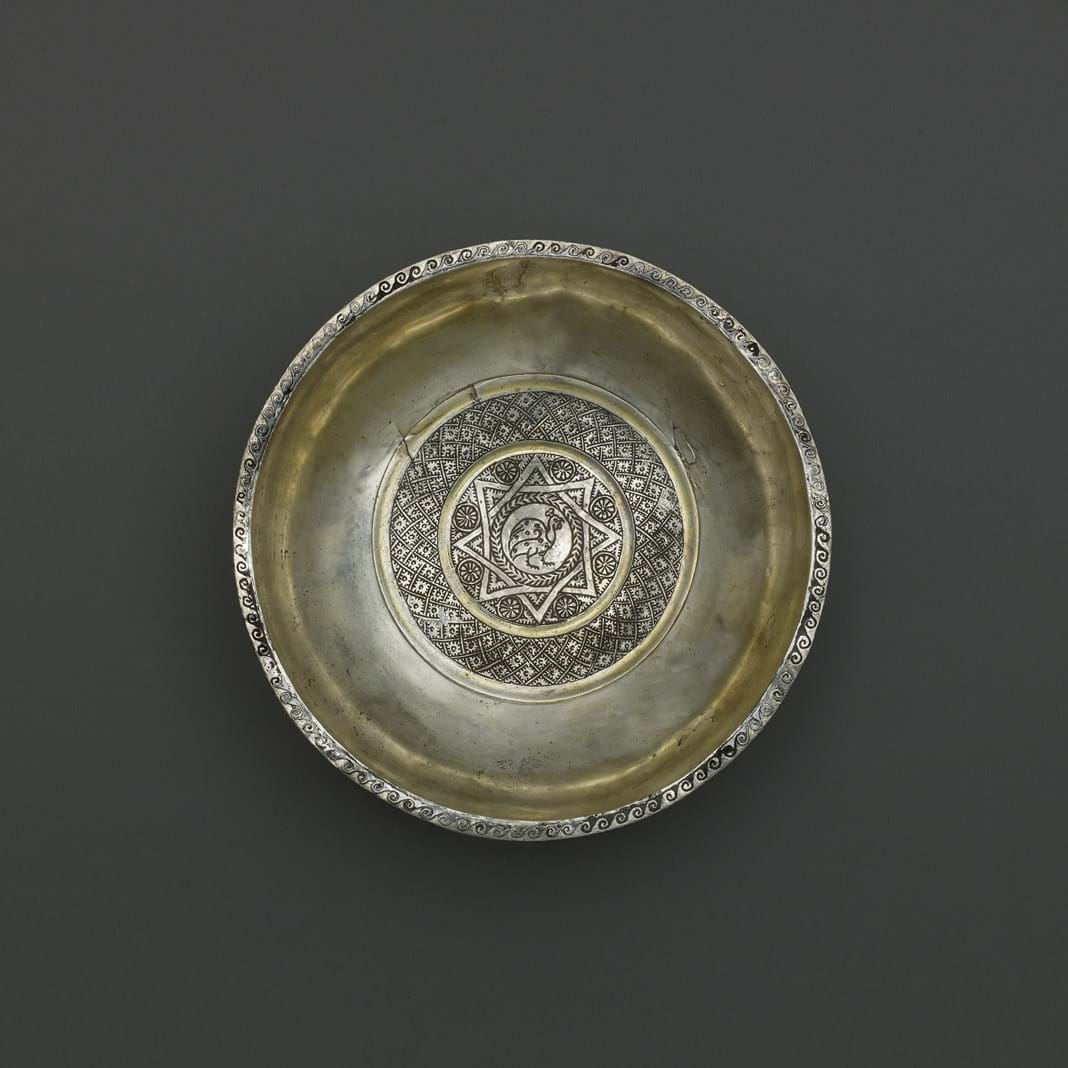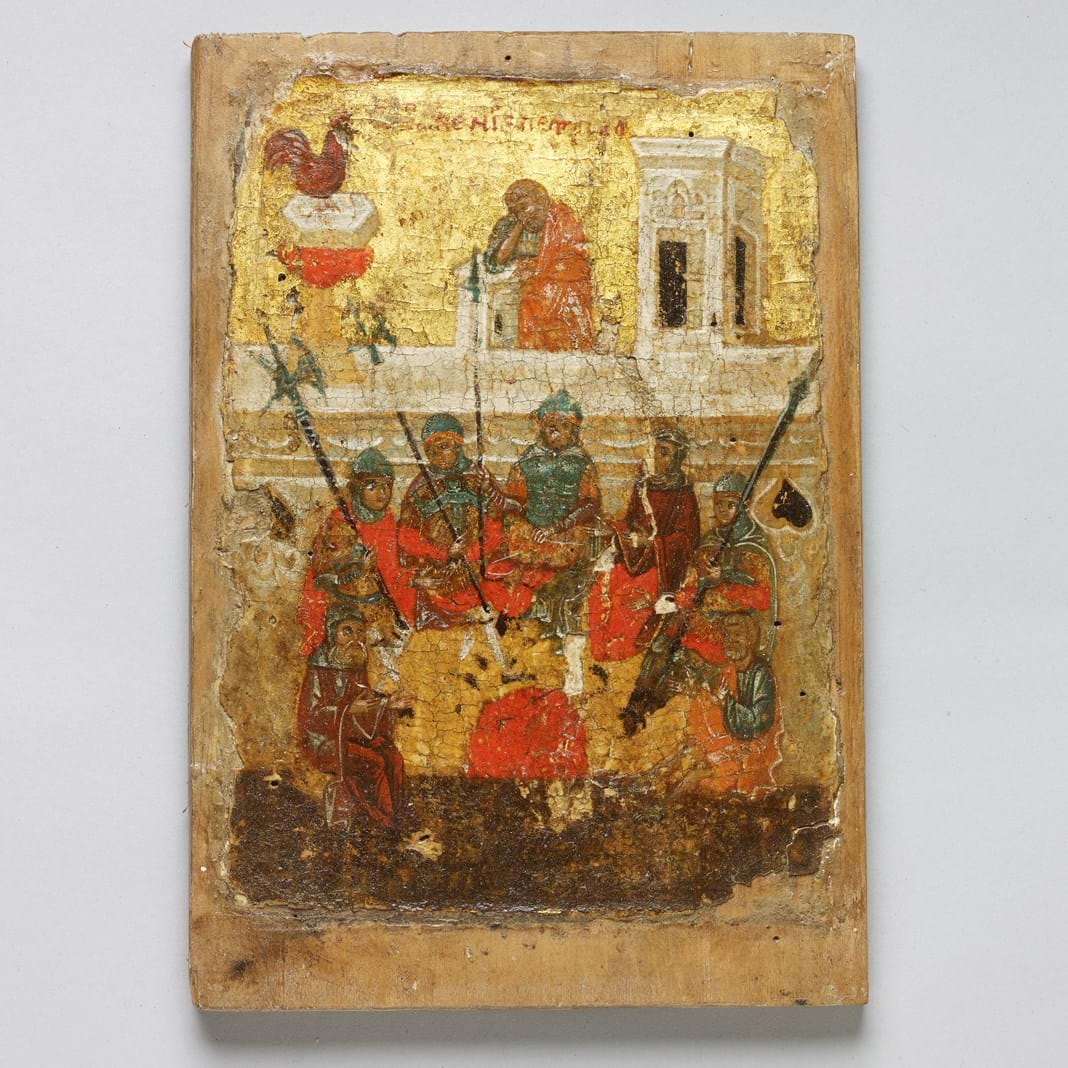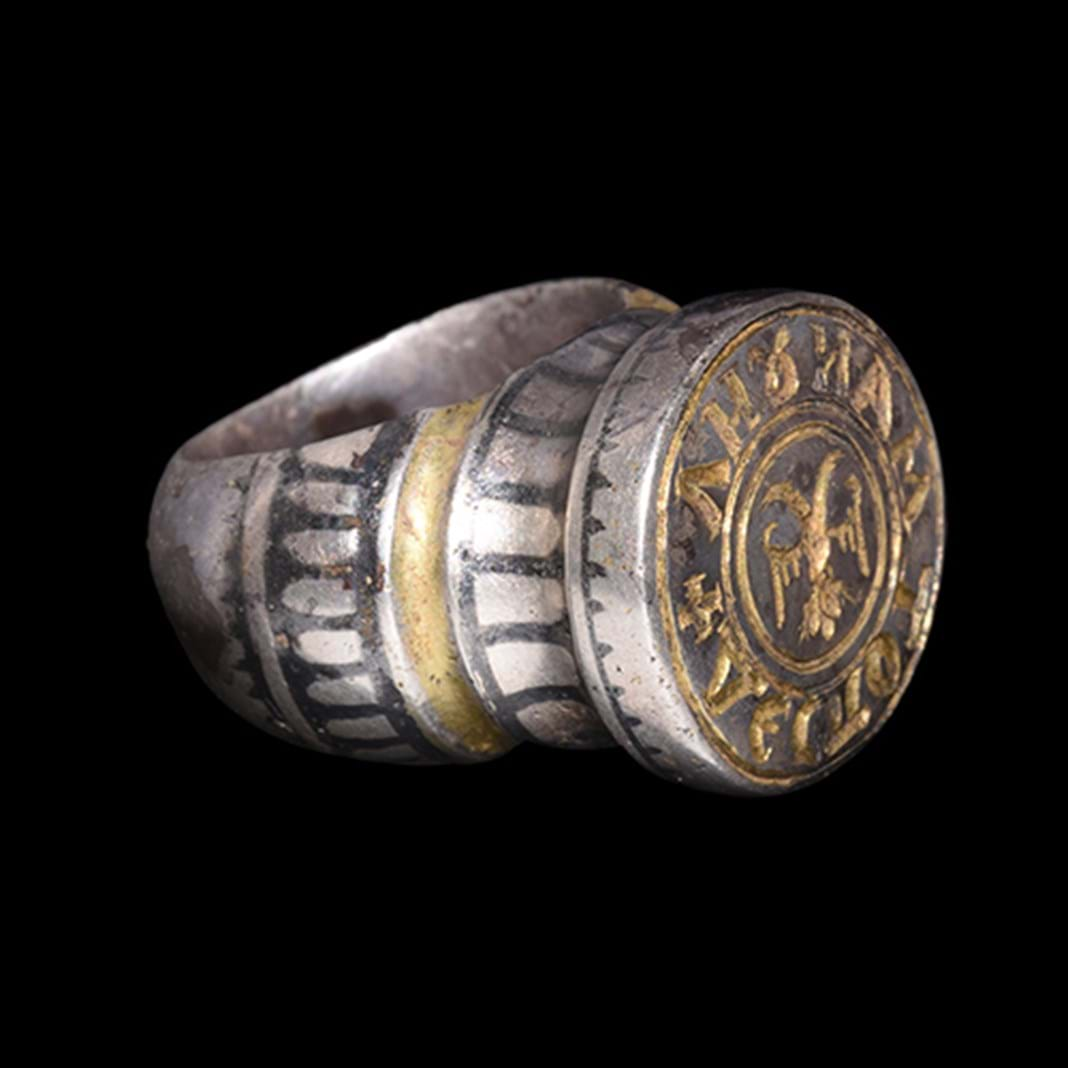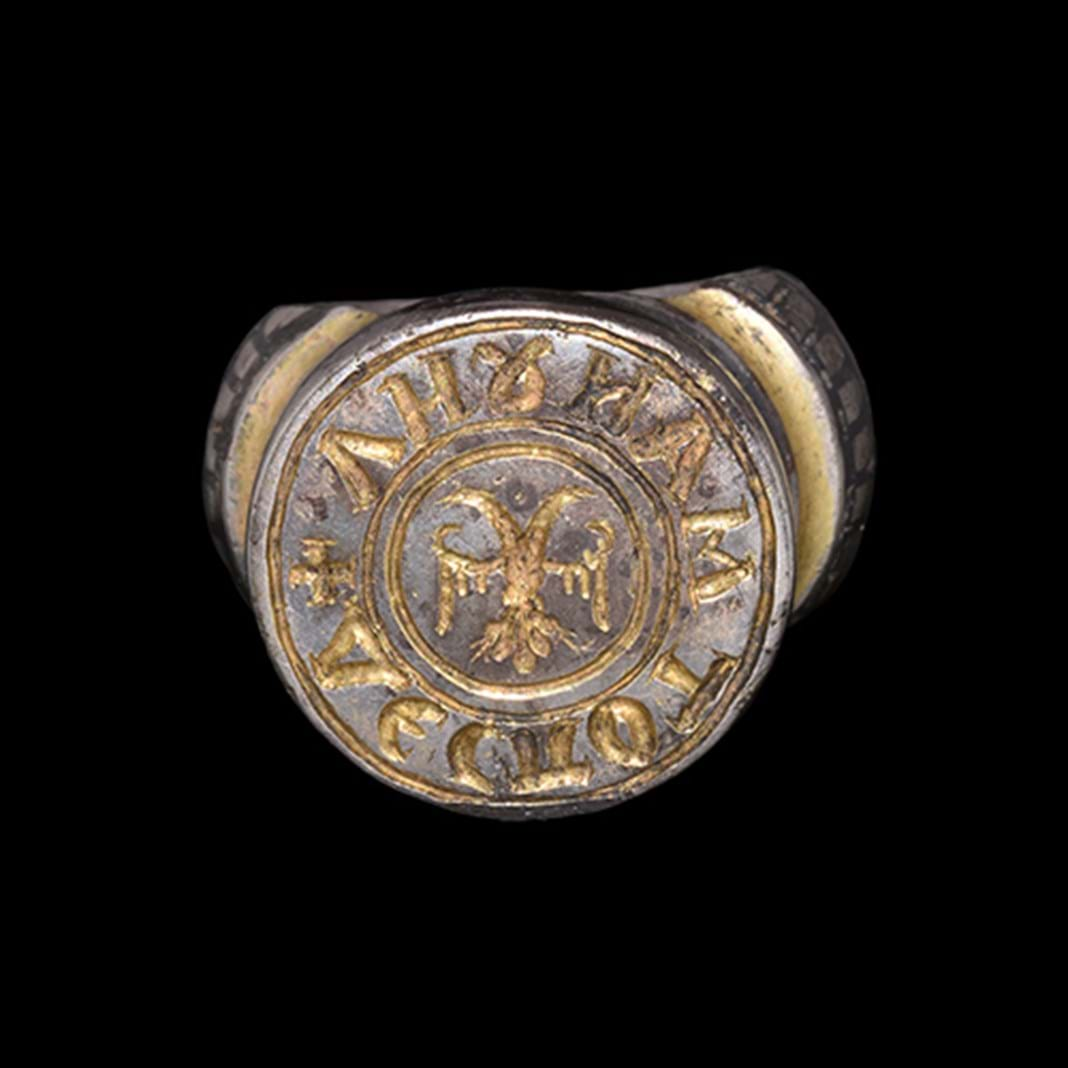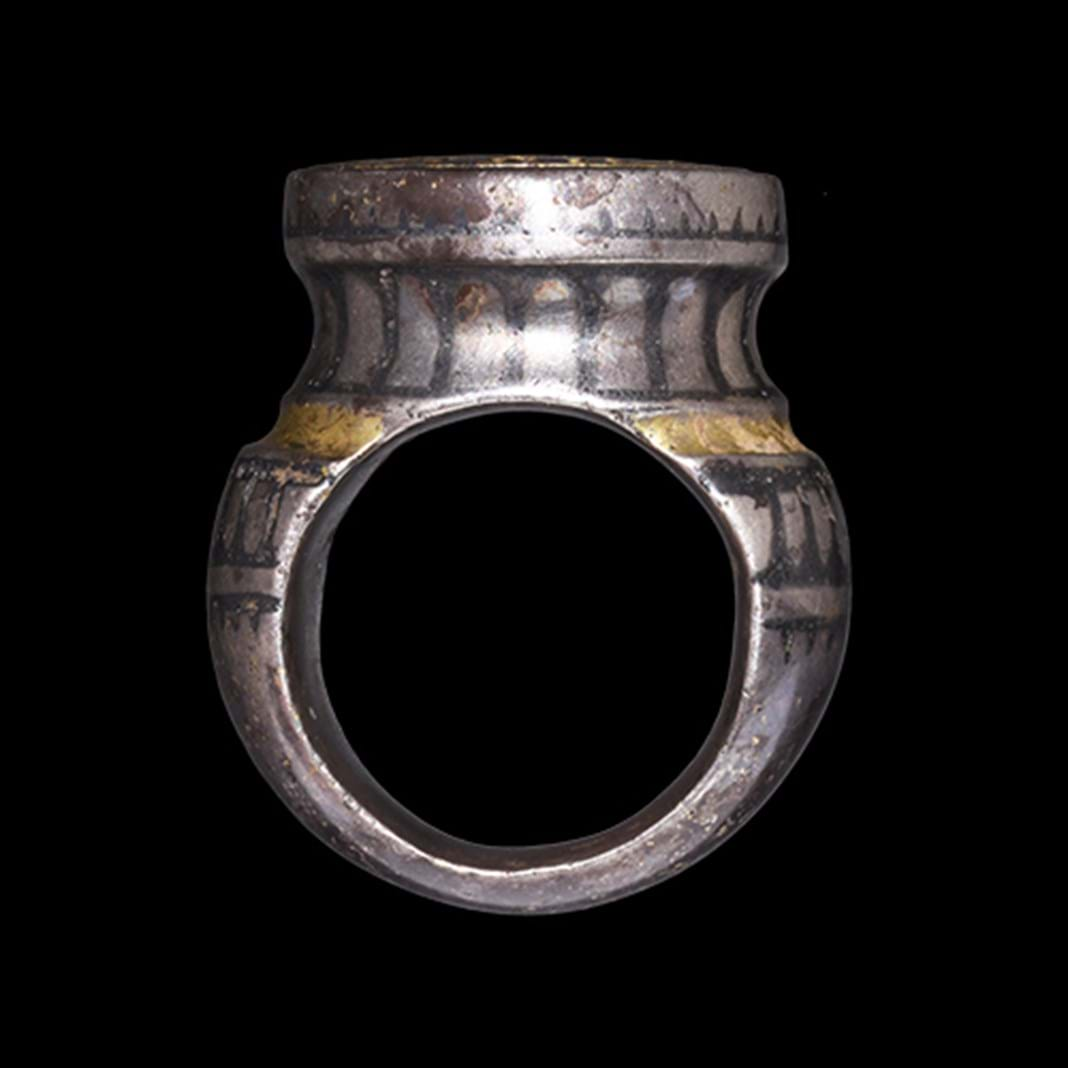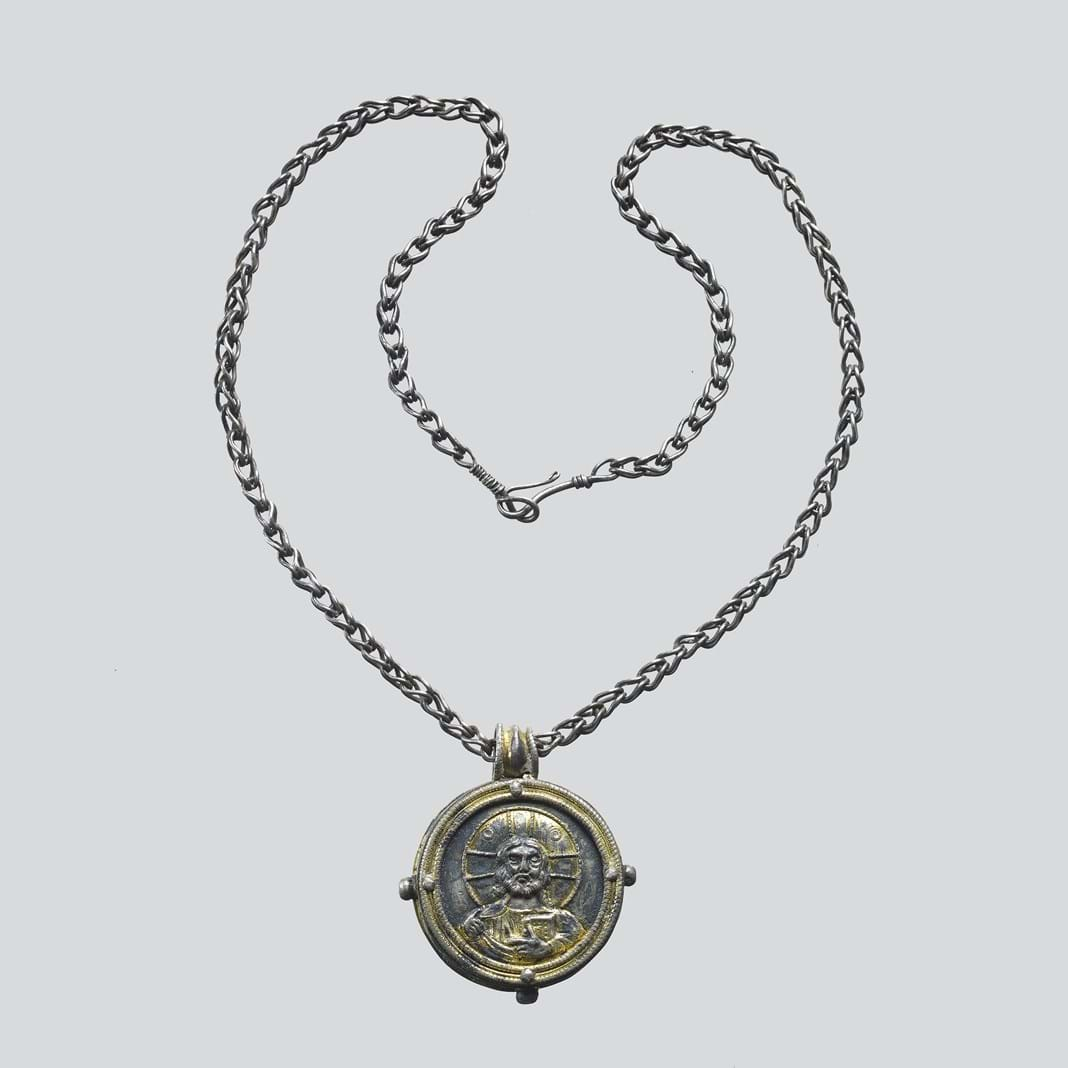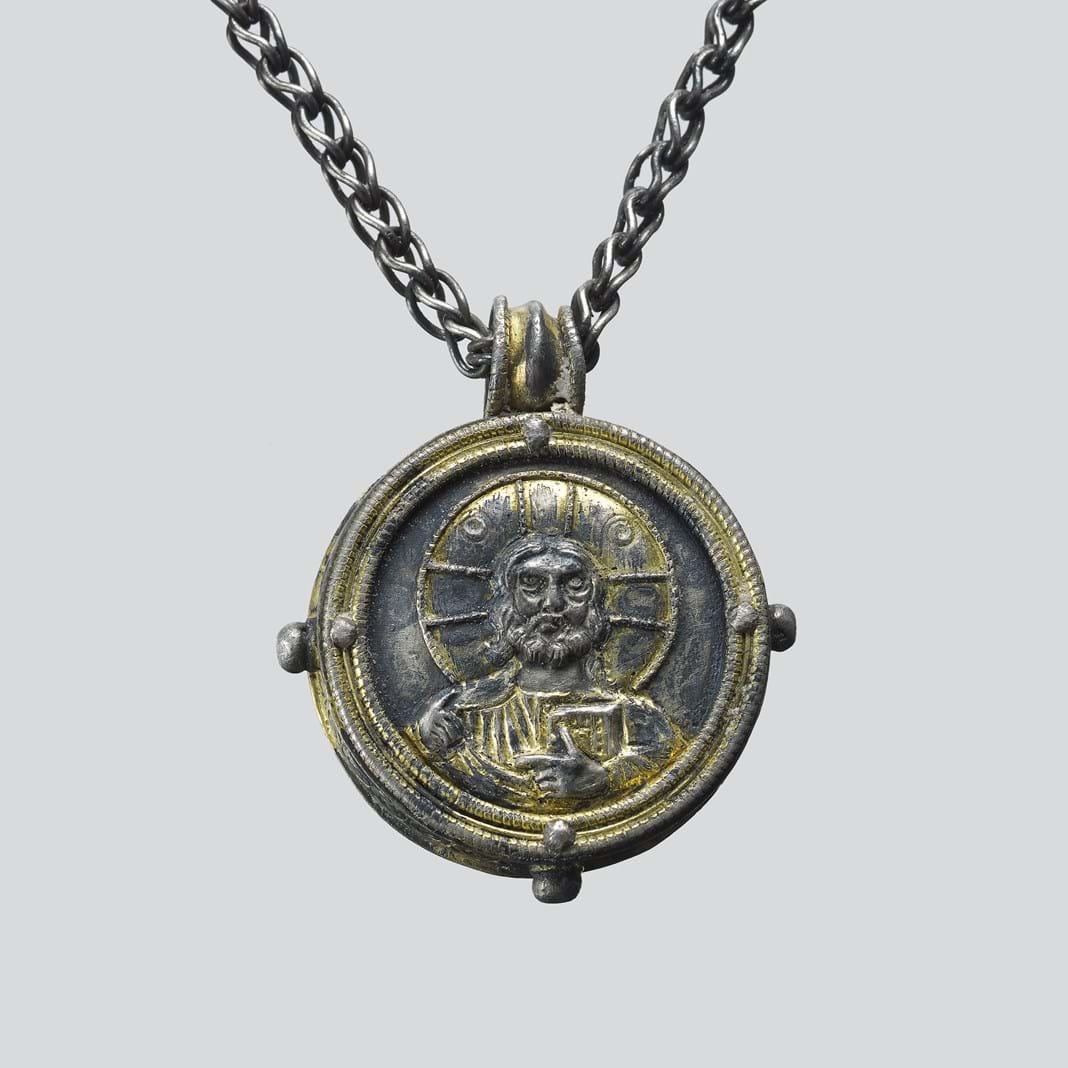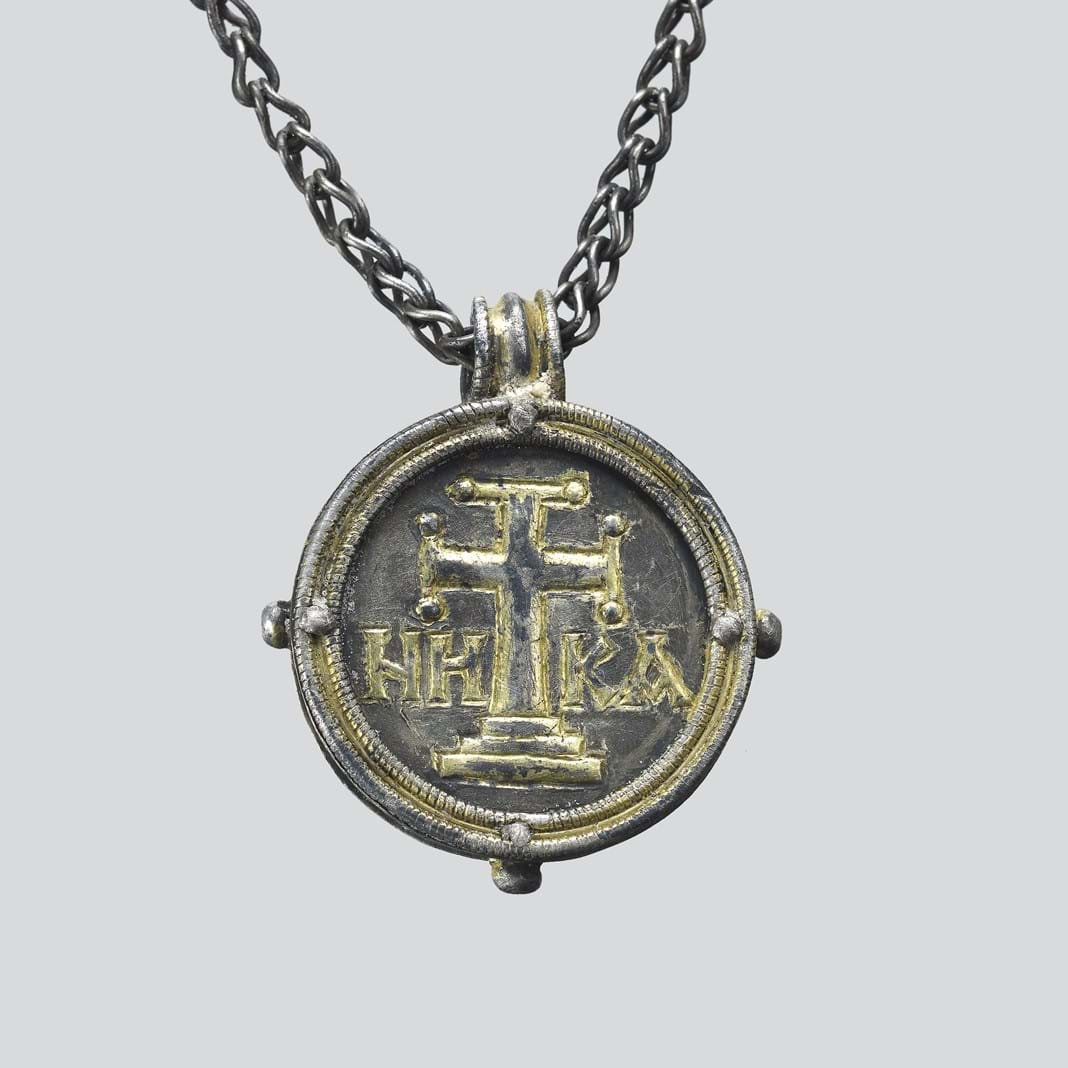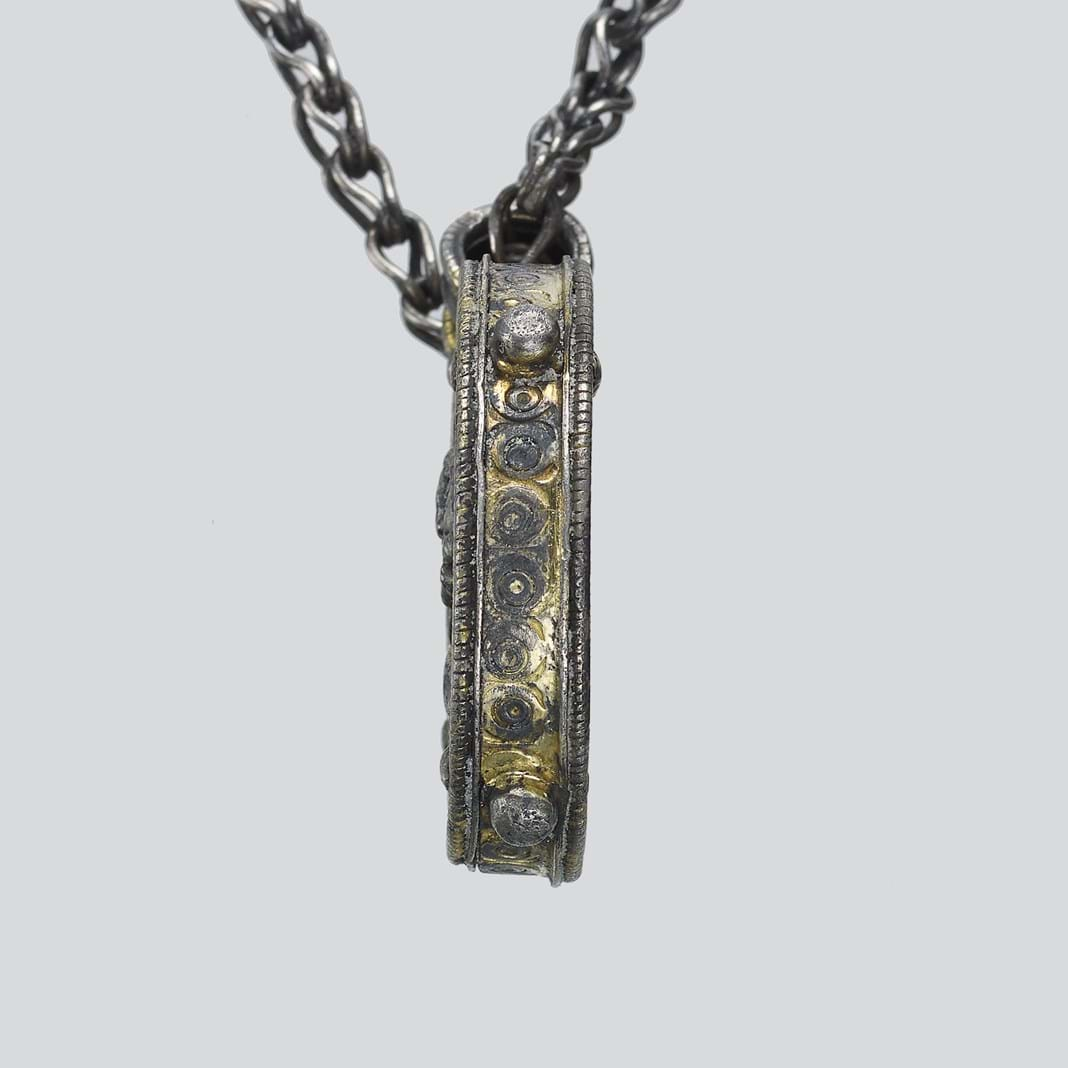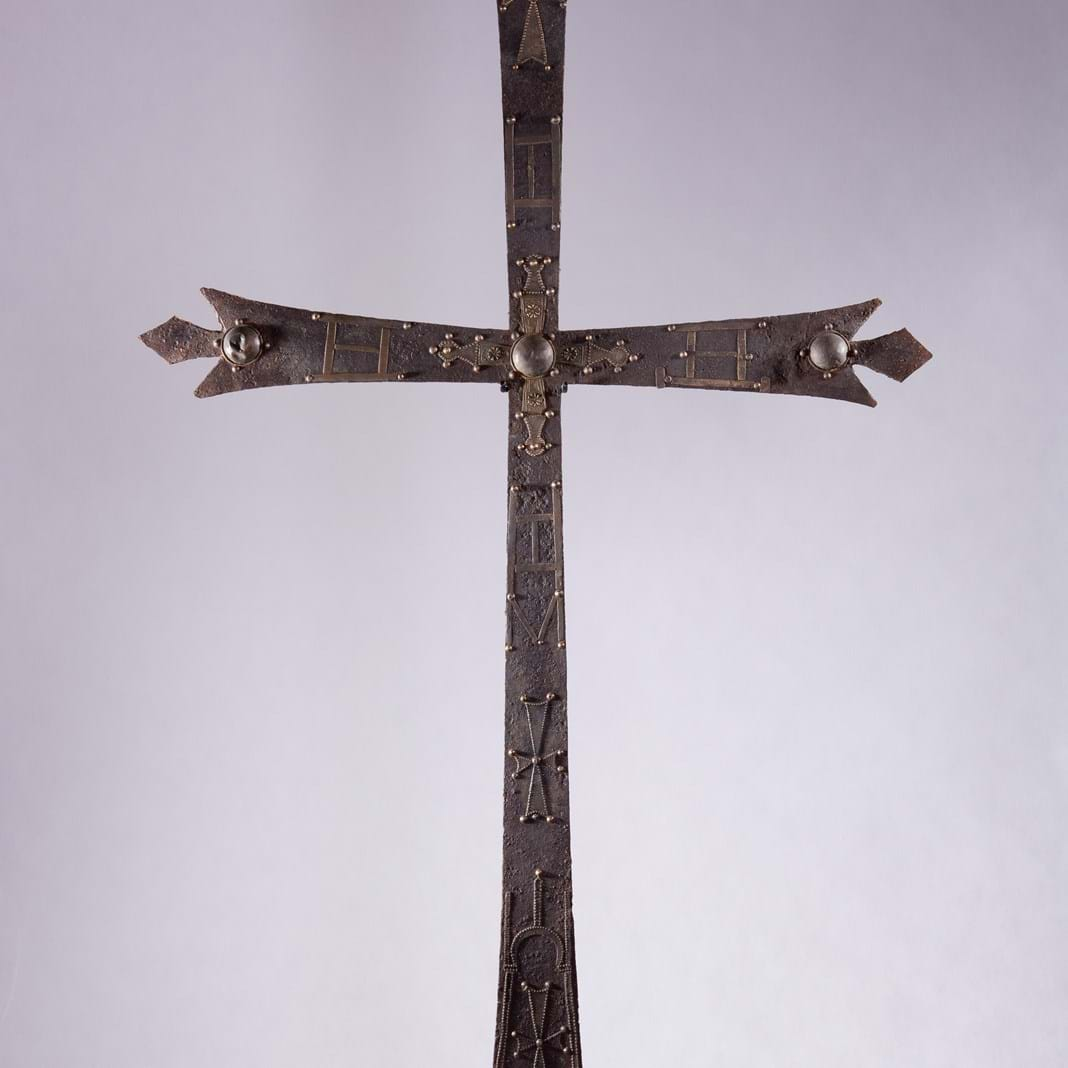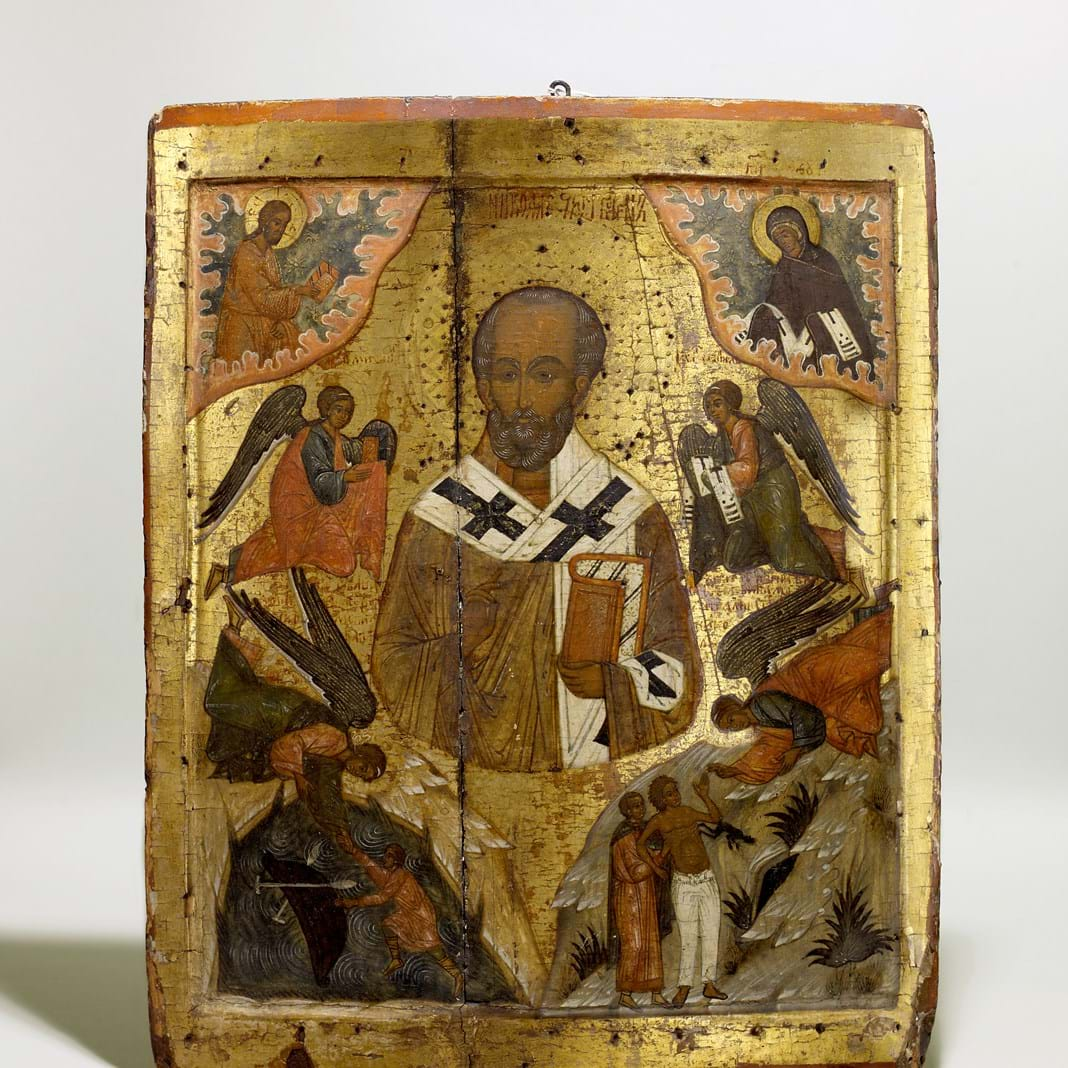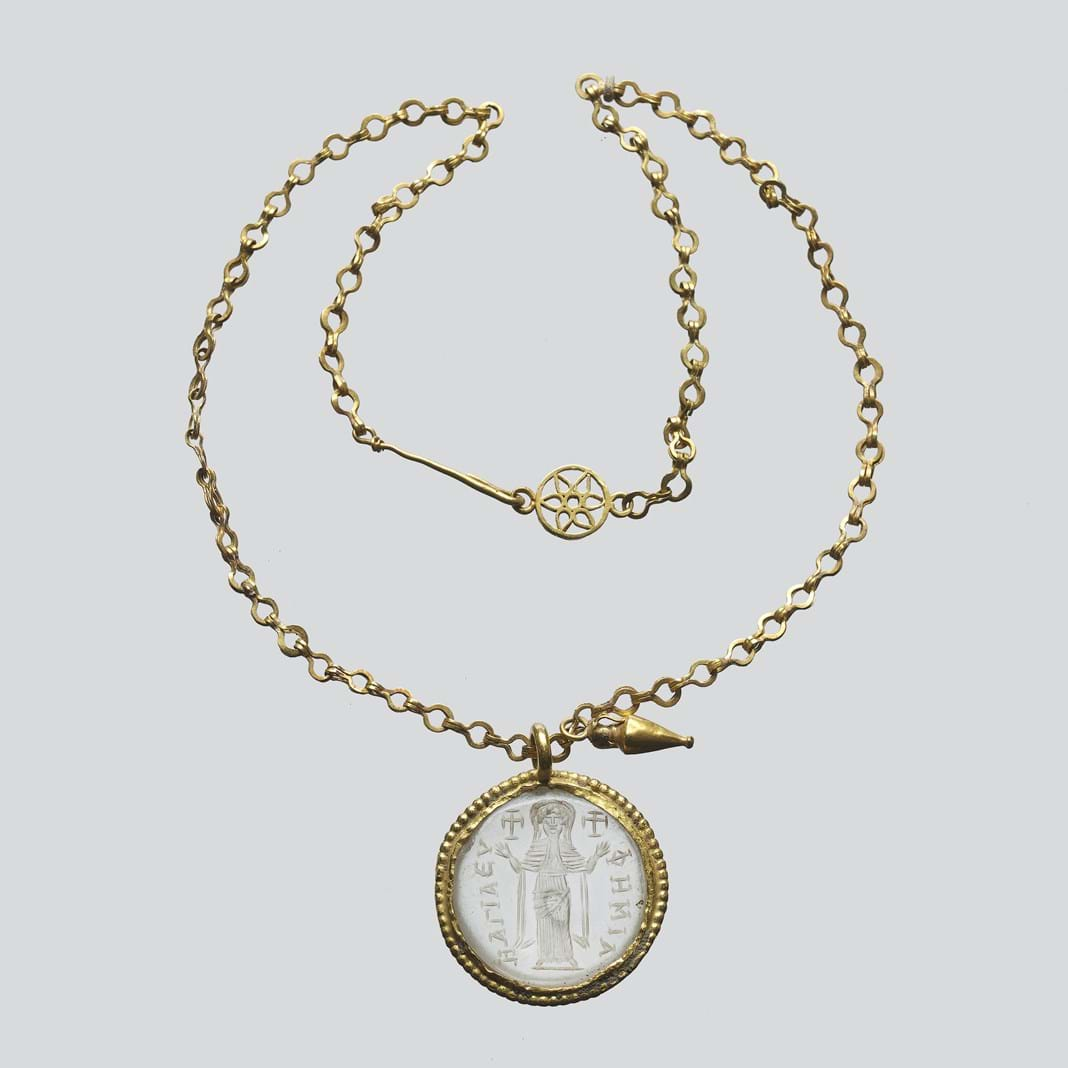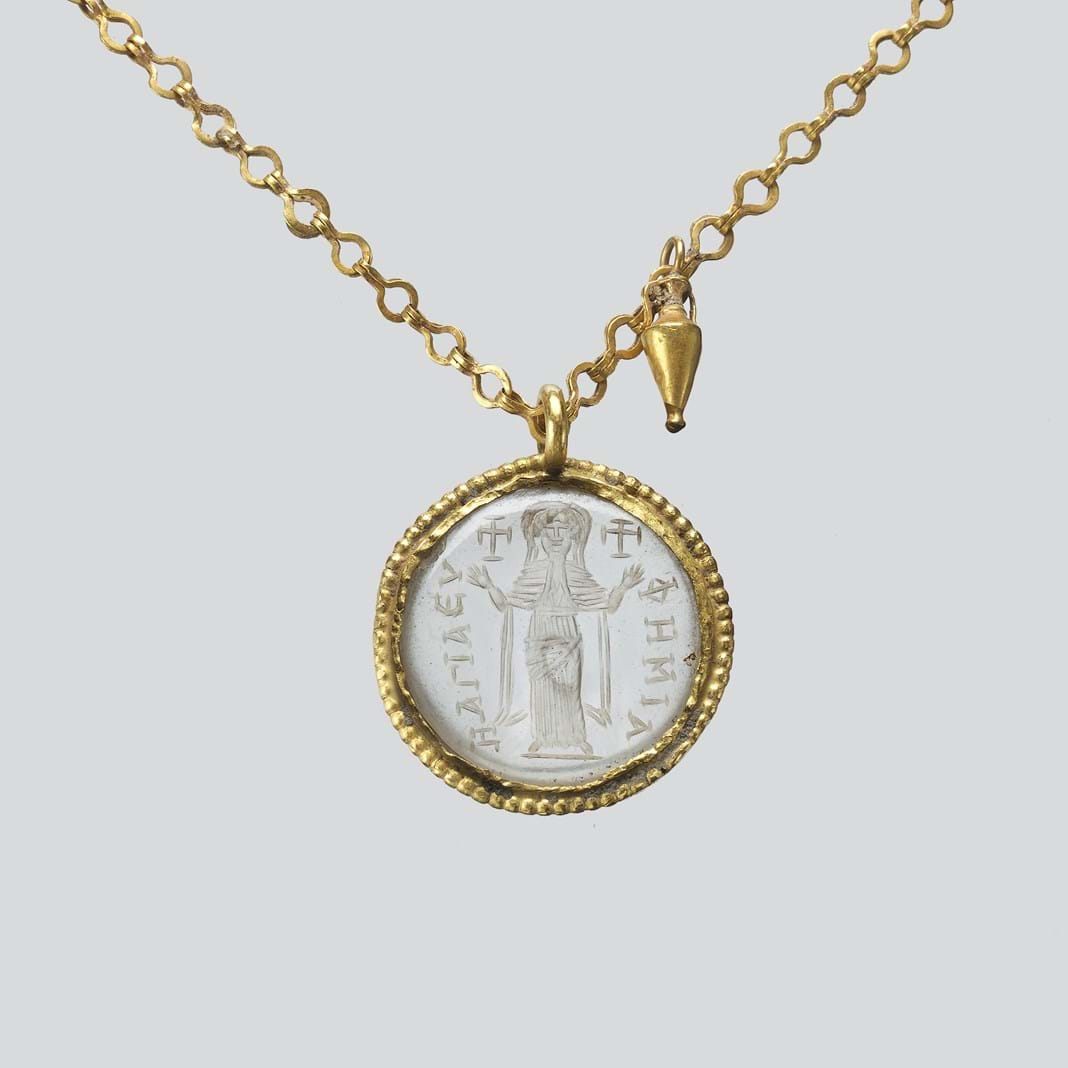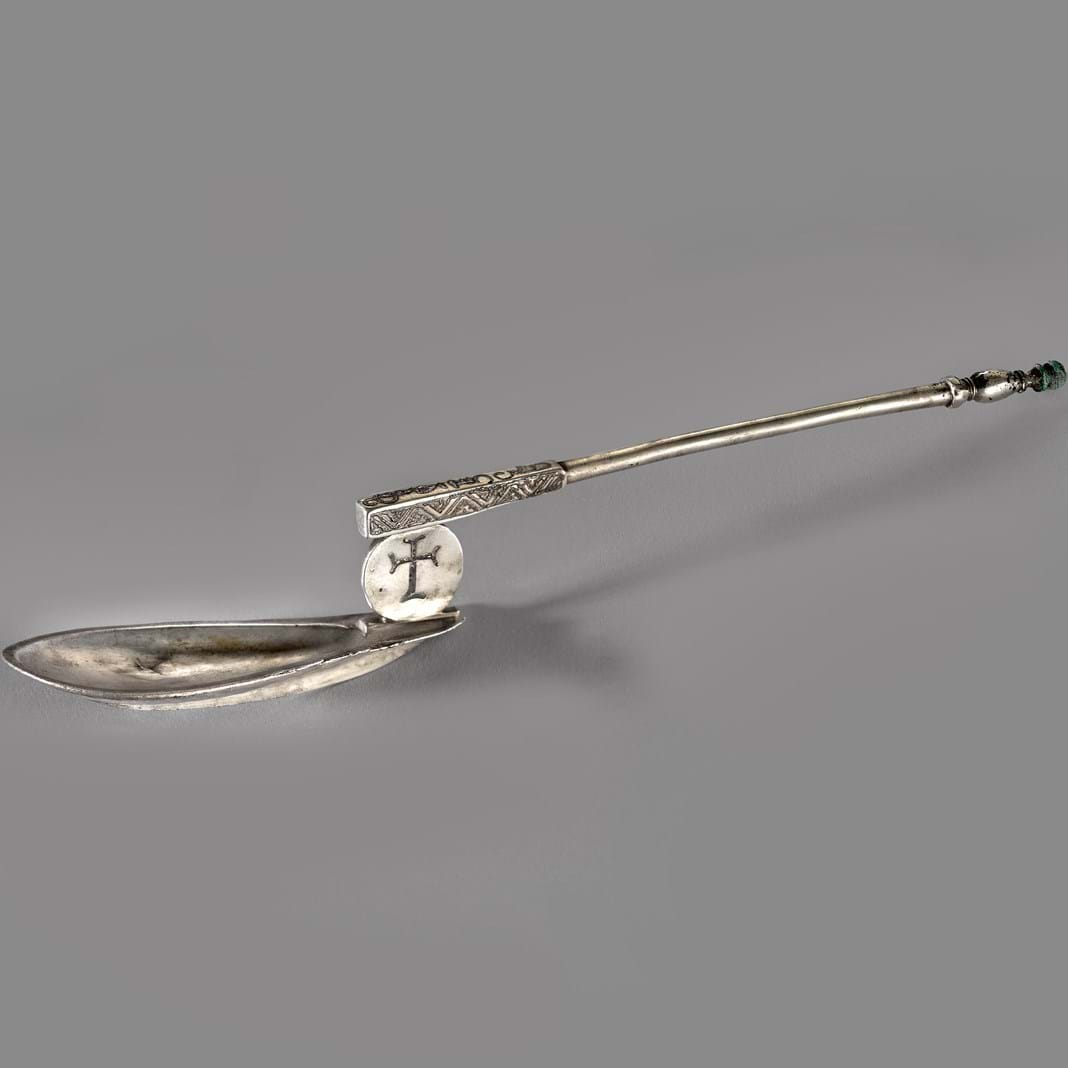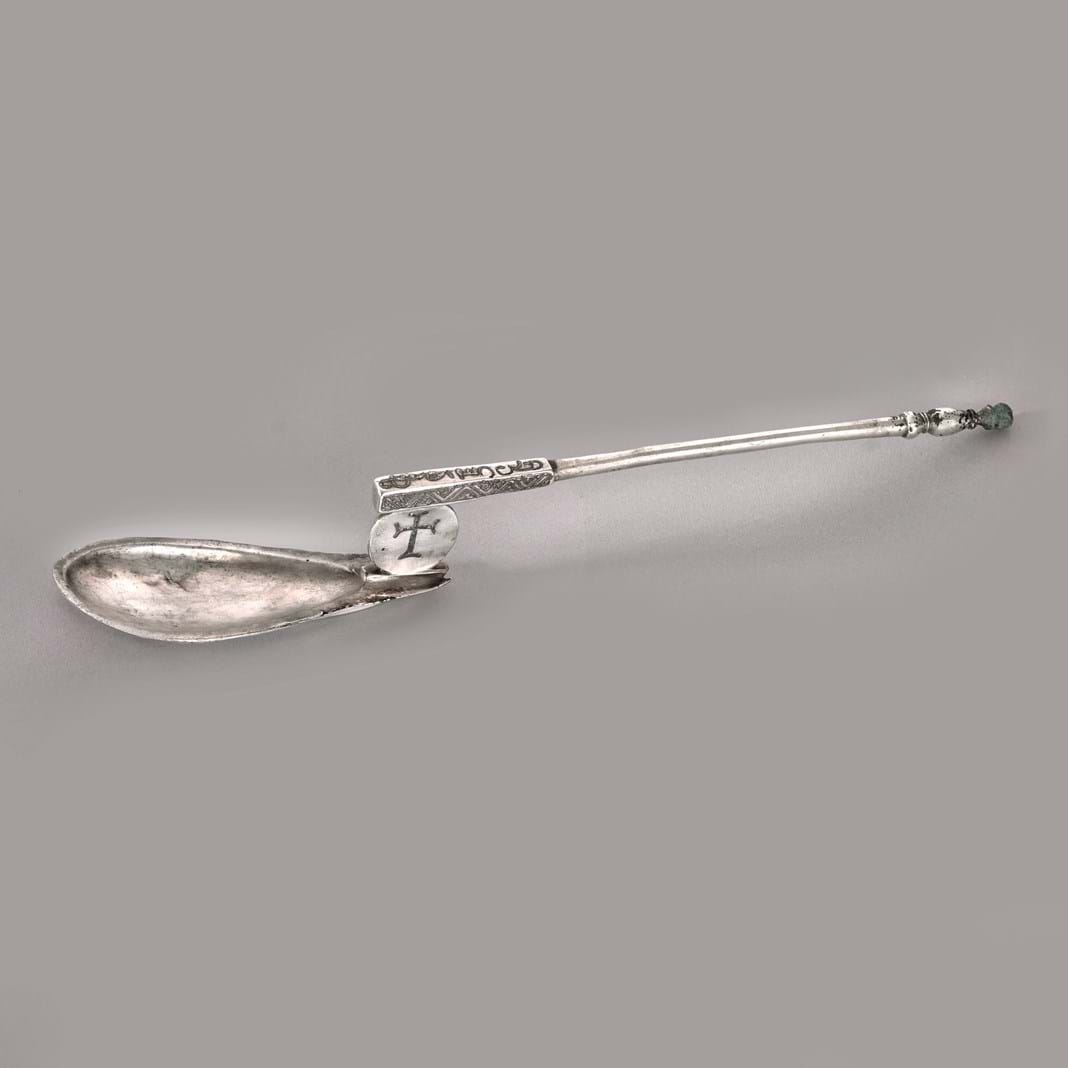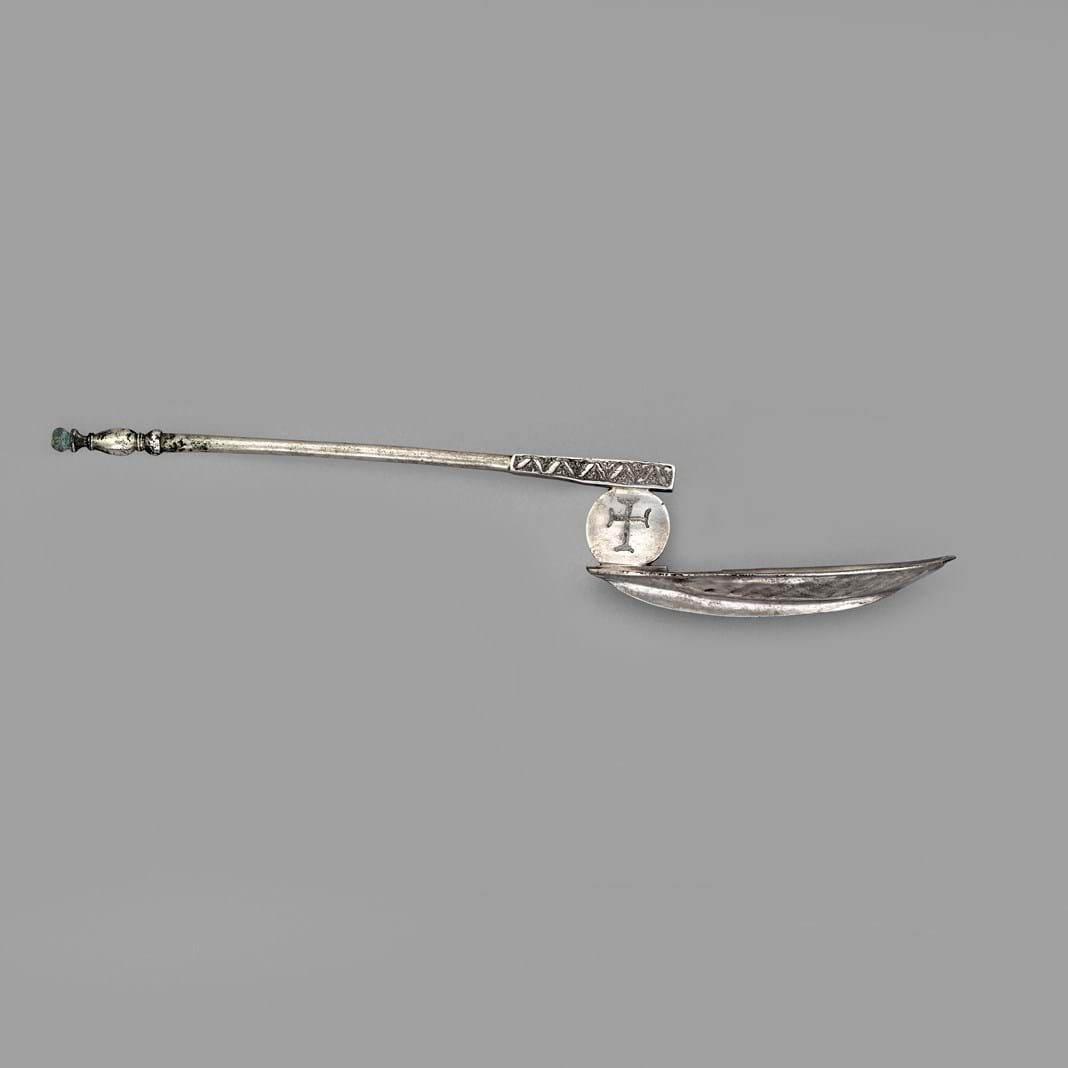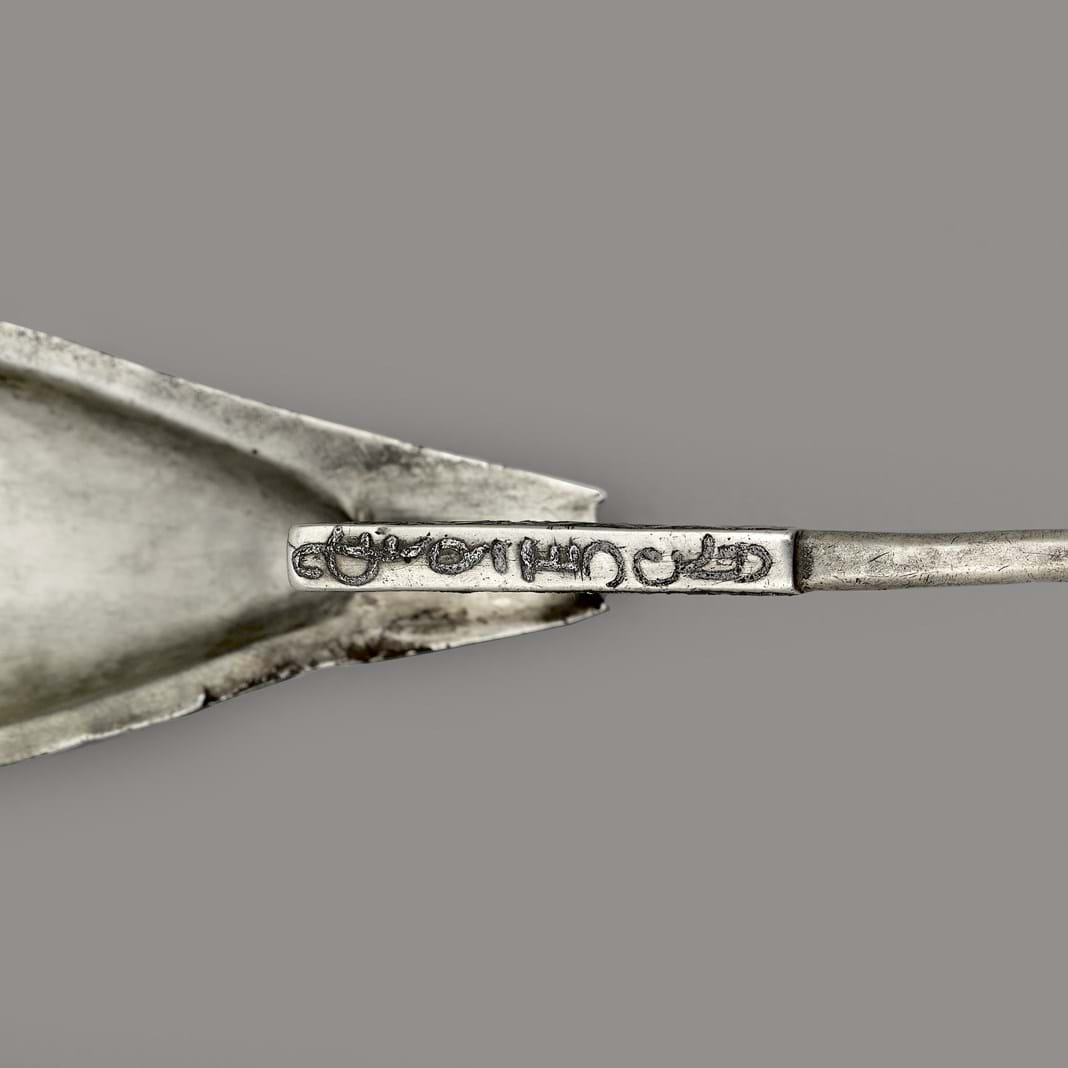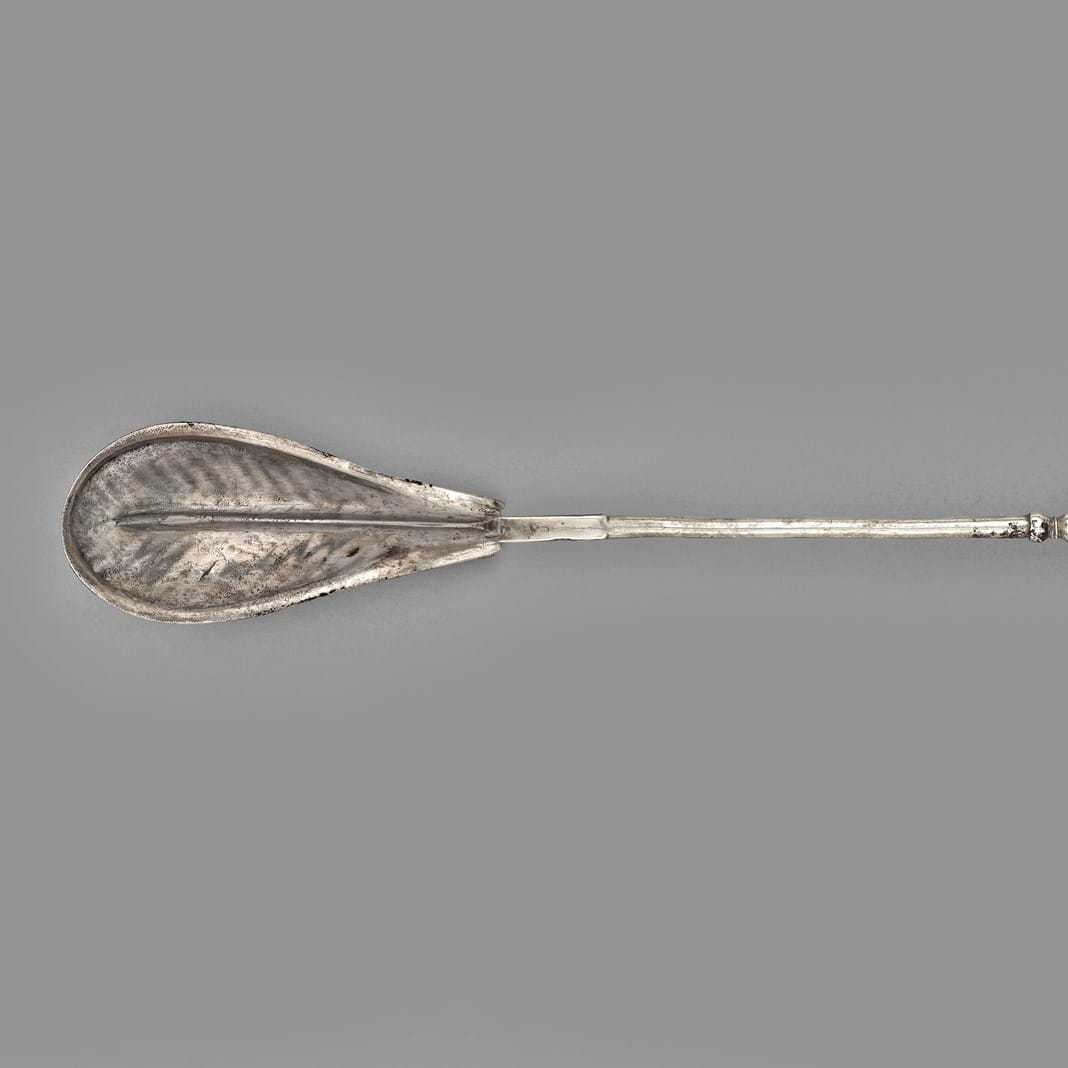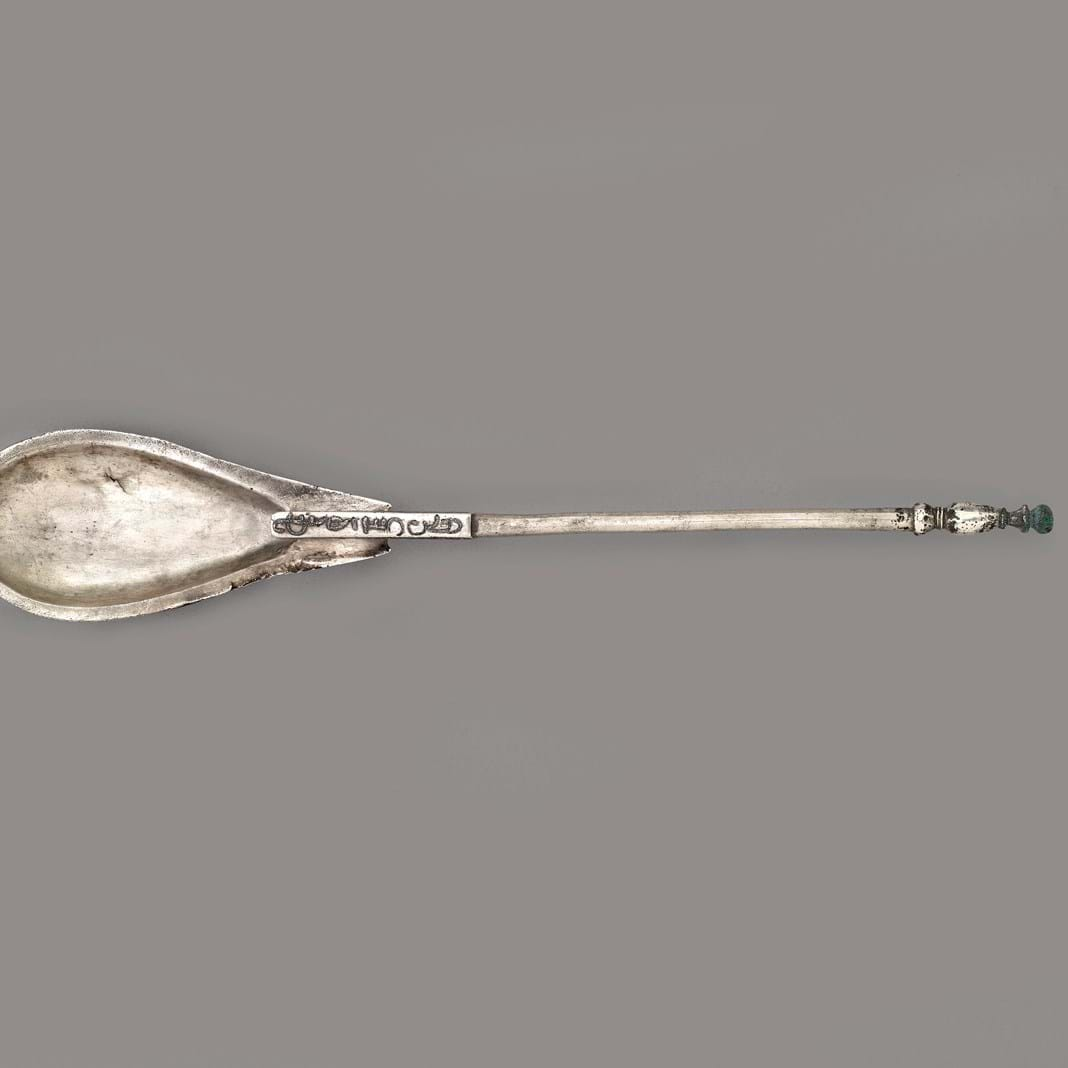Parcel-gilt silver bowl on high foot inlaid with niello
The body of the bowl is softly fluted on the exterior, while the gilded surface of the interior is plain and smooth, a feature indicating that the body is double-skinned. The rim is decorated with a continuous wave pattern inlaid with niello as are the two concentric roundels at the bottom of the bowl. At the centre, an eight-pointed star containing a wreathed roundel with a partridge or pea hen. The outer roundel is engraved with a diaper pattern of small diamonds containing rosettes
Until recently considered Sassanian on account of its shape, the nielloed decoration on the rim and in the centre finds many direct parallels in Late Roman-Early Byzantine silver which directly contradict this attribution.
Origin
Eastern Mediterranean
Date
Late Roman-Early Byzantine period; late 4th – early 5th century
Height: 9 cm
Diameter: 18.40 cm
Weight: 582 g
Provenance
Collection of R H, New York, 1980s
Gorny & Mosch Auction sale, Munich, 16/06/ 2016, lot 369
The Denial of St Peter
Tempera and gold on gesso, on carved lime wood panel.
The subject illustrates an event described in all four gospels (Matthew 26:69–75; Mark 14:66–72; Luke 22:55–62; John 18:17–18, 25–27). When Christ was arrested, Peter followed him into the courtyard of the High Priest’s palace where servants and officers stood warming themselves against the cold around a coal fire. And Peter stood with them to warm himself. There he was confronted on three separate occasions and accused of being a disciple of Jesus. Peter denied each and in so doing fulfilled Christ's prophecy that before the cock crowed twice he would deny him thrice. And Peter remembering the words of the Lord, went out, and wept bitterly.
Despite the emphasis given to the event by all four evangelists, this appears to be the only recorded representation of this theme in icon painting.
Origin
Byzantine provincial work
Date
late 14th-early 15th century
Height: 24 cm
Width: 16.5 cm
Provenance
Private collection Bucharest (bears a Romanian export stamp on the back and is accompanied by an export document)
Acquired by AXIA in London in 2009
Signet ring of the Despot Manuel
Solid parcel-gilt and nielloed silver with a substantial D-section hoop and a circular bezel on a waisted stem. The bezel face is chased with a double-headed eagle surrounded by the legend ‘ΔΕΣΠΟΤ[ΟΥ] ΜΑΝΟΥΗΛ’ (of, or belonging to, the Despot Manuel) carved in mirror image as a seal.
Origin
Epirus work, Northern Greece
Date
2nd half 14th century
Height: 3.2 cm
Diameter: 1.71 cm (internal)
Weight: 62 g
Size / Dimensions
Approx. ring size: British N; USA 6 ½; Europe 13.72; Japan 13
Provenance
From an old European collection; acquired in Munich in the 1970s.
TimeLine Auctions, 23/05/2017, lot 295
Acquired there by AXIA
Byzantine parcel-gilt silver reliquary pendant and chain
In the form of a circular container with ribbed and beaded loop, beaded bands to each face, roundels to the edge and three lugs to seal the reliquary. On the obverse, executed in repoussé, facing bust of Christ with cross to the halo, holding the Gospel in the left hand; on the reverse, executed in a combination of repoussé and engraving, a ‘Latin’ cross pommée on steps flanked by the legend NH-KA, an abbreviation of IC XC NIKA, ‘Jesus Christ is victorious’. The silver chain with a swan-neck hook and eye wire closure.
Despite the archaic features of the decoration, especially the cross on steps on the reverse which is reminiscent of representations on 7th-century coinage, the workmanship of this reliquary is stylistically and technically in keeping with silverwork from the Palaeologan period in northern Greece. Its gilding displays the characteristics of the medieval and later tradition of silversmithing in Epirus. This was established in the late Byzantine period and has flourished there ever since, originally because of its relative proximity to the new silver mines of Srebrenica in modern Bosnia (srebro in Slavonic = silver), whose beginnings also hark back to the 14th century. Epirus silverware is often referred to as Yannina work after the name of Epirus’ principal city.
Origin
Northern Greece, probably Epirus
Date
Palaeologan period, ca. 1300-1400 AD
Height: 5 cm (reliquary)
Length: 55 cm (chain)
Diameter: 3.6 cm (reliquary)
Weight: 46 g
Provenance
From an old German collection; acquired in Munich in the 1970s.
TimeLine Auctions, 06/12/2016, lot 439
Acquired there by AXIA
Byzantine Processional Military Cross
Made of iron with gently flaring arms terminating in spear heads and decorated with a variety of appliqué motifs in copper alloy. At the base a funnel-like base to mount the cross on a wooden staff
Date
Middle Byzantine period, 10th-12th century
Height: 150 cm
Width: 78 cm
Thickness: 0.3 cm
Provenance
Property of Micheal Dennis O'Hara, 1967
Private Collection TS, London
Exhibited / Published
Museum of Kykkou Monastery, Cyprus, 2015
Saint Nicholas with Angels & Miracles
Tempera and gold on gesso, on carved limewood panel. This icon is the earliest known version of a very rare iconographic composition. It was sold by the Soviet government for hard currency in the late 1920s and is the subject of an in-depth study by Prof. Engelina Smirnova, reproduced here in the ‘extended entry’.
Origin
Russia, Novgorod
Date
ca. 1550
Height: 54 cm
Width: 42 cm
Provenance
Handwritten label on the back "Muzei izyashnykh isskustv" (the name of the Pushkin Museum before 1932). Most likely sold at Torgsin, the Soviet foreign currency shops that existed 1931-6.
Purchased in Russia in the 1930s by American Collector
Ken Farmer Auctions, 03/05/2009, Mixed sale, lot 290
Acquired there by AXIA
Exhibited / Published
Museum of Russian Icons Journal of Icon Studies: Saint Nicholas the Wonderworker with Angels and Miracles, January 2012
Gold-mounted rock crystal pendant with Saint Euphemia
The saint is shown standing on dais in the position of an oranta, her head flanked by Latin crosses with 'T-shaped' terminals. She is identified by an inscription in Greek + ‘ΑΓΙΑ ΥΦΗΜΙΑ’ , ’St Euphemia’.
The circular medallion is made of two rock crystal lenses with smooth outer faces. The back of the front lens is carved in intaglio and in reverse so it can be read correctly from the front. The lenses are held together by the gold rim.
The short length of the chain suggests this pendant was probably intended for a child.
Origin
Eastern Mediterranean
Date
Late Roman-early Byzantine period, ca. 6th century
Length: 38 (chain)
Diameter: 2.60 cm (pendant)
Weight: 12.76 g
Provenance
Private collection, Alexandria 1930s-1956
Private collection Geneva 1956 – 1978
Acquired by AXIA 1978
Early Byzantine silver spoon with inscription in Middle Persian
Of the characteristic early Byzantine type (see also No.13, R005075), the bowl of this spoon is double skinned; plain on the inside and ribbed in repoussé on the outside. It is strengthened on the underside with a fin. The presence of the latter confirms it was a serving spoon or ligula, rather than a cochlearion or eating spoon
The lower part of the handle is inlaid with niello and inscribed in Middle Persian. The disc joining the two is similarly niello-inlaid with a cross with pronounced ‘bracket’ terminals on both sides similar to Leo Heraclius coins.
The presence of the inscription in the form of Persian used by the Sassanians, the Byzantines’ regular adversaries testifies to the presence on a wealthy community of Christians between them. One one other related spoon is known to us. Indeed, it is so similar in all aspects that it was perhaps once part of the same set. (see, Spier, J., Treasures of the Ferrell Collection, Wiesbaden, 2010, p.304, cat.225).
Origin
Mesopotamia or Western Iran
Date
6th-7th century
Length: 22.5 cm
Weight: 64 g
Provenance
IR collection,1960-1980
IV collection,1980-2014
Acquired by AXIA in the London Trade (SS) 2016
